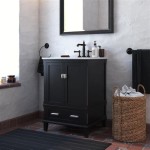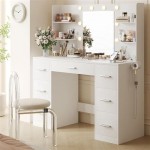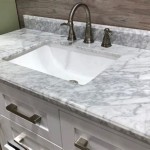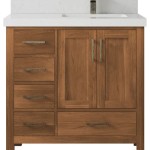Bathroom Vanity With Top 48 Inch: A Comprehensive Guide
The bathroom vanity serves as a focal point in any bathroom, offering not only storage solutions but also contributing significantly to the room's overall aesthetic. Among the various sizes available, the 48-inch bathroom vanity with top stands out as a versatile option suitable for a wide range of bathroom layouts. This size offers a balance between ample counter space and storage capacity, making it a popular choice for both master bathrooms and larger guest bathrooms.
When selecting a 48-inch bathroom vanity with top, it is crucial to consider various factors such as material, style, functionality, and installation requirements. This guide aims to provide a comprehensive overview of these factors, assisting homeowners in making informed decisions when purchasing a 48-inch bathroom vanity with top.
Understanding the Dimensions and Spatial Requirements
A 48-inch bathroom vanity, as the name suggests, measures approximately 48 inches in width. The depth typically ranges from 18 to 22 inches, and the height usually falls between 30 and 36 inches. These dimensions allow for comfortable use while also providing sufficient storage space beneath the sink. However, simply knowing the dimensions is not enough; one must consider the surrounding space and the bathroom's layout.
Before purchasing a 48-inch vanity, measure the dedicated space in the bathroom. It is essential to allow for adequate clearance around the vanity for comfortable movement. A general rule of thumb is to leave at least 30 inches of clear space in front of the vanity. This ensures that individuals can comfortably stand and use the sink without feeling cramped.
Furthermore, consider the placement of other bathroom fixtures, such as the toilet and shower. Ensure that the vanity does not obstruct access to these fixtures or create a cramped and uncomfortable environment. In smaller bathrooms, carefully planning the layout may involve choosing a vanity with a shallower depth to maximize space. It is also advisable to consider the placement of doors and windows, ensuring that the vanity does not interfere with their operation.
The placement of plumbing is another crucial factor. Existing plumbing connections will largely dictate the vanity's position. Moving plumbing can be costly and time-consuming, so it's typically more practical to choose a vanity that aligns with the existing plumbing layout. If relocating plumbing is necessary, it's recommended to consult with a qualified plumber to assess the feasibility and cost involved.
Exploring Materials and Styles for 48-Inch Vanities
The choice of materials and style significantly impacts the appearance and durability of a 48-inch bathroom vanity with top. A wide array of materials is available, each offering its unique benefits and aesthetic qualities. Similarly, a variety of styles caters to diverse design preferences, ranging from traditional to contemporary.
Vanity Cabinet Materials:
Common materials for vanity cabinets include solid wood, plywood, MDF (Medium-Density Fiberboard), and particleboard. Solid wood is prized for its durability and natural beauty, but it is also the most expensive option. Plywood is a durable and stable alternative, often used in high-quality vanities. MDF is a cost-effective option that provides a smooth surface for painting or laminating. Particleboard is the least expensive option but is also the least durable and susceptible to moisture damage.Countertop Materials:
Countertop materials include natural stone (granite, marble, quartz), engineered stone (quartz), solid surface materials, and laminate. Granite and marble offer a luxurious and timeless aesthetic, but they require regular sealing to prevent staining. Quartz is an engineered stone that is highly durable, stain-resistant, and low-maintenance. Solid surface materials are non-porous and easy to clean, making them a practical choice for bathrooms. Laminate countertops are the most affordable option but are less durable and may be susceptible to scratches and water damage.Styles:
Bathroom vanity styles encompass a broad spectrum, including traditional, modern, transitional, and rustic. Traditional vanities often feature ornate details, raised panel doors, and antique-inspired hardware. Modern vanities typically have clean lines, minimalist designs, and sleek hardware. Transitional vanities blend elements of both traditional and modern styles, offering a versatile and timeless aesthetic. Rustic vanities incorporate natural materials, such as reclaimed wood, and feature a distressed or weathered finish.Selecting the appropriate material and style requires careful consideration of one's budget, design preferences, and lifestyle. For example, a busy family bathroom may benefit from a durable and low-maintenance vanity made of quartz countertop and MDF cabinet. In contrast, a master bathroom may warrant the investment in a solid wood vanity with a granite countertop to create a luxurious and spa-like atmosphere.
Focusing on Functionality and Storage Solutions
Beyond aesthetics, the functionality and storage capacity of a 48-inch bathroom vanity with top are crucial considerations. A well-designed vanity can significantly enhance the organization and efficiency of a bathroom. Different storage solutions are available, each catering to specific needs and preferences.
Drawer and Cabinet Configurations:
Vanities can feature a variety of drawer and cabinet configurations. Drawers are ideal for storing smaller items, such as toiletries, makeup, and hair accessories. Cabinets are better suited for storing larger items, such as towels, cleaning supplies, and extra toilet paper. The placement and size of drawers and cabinets should be carefully considered to maximize storage space and accessibility.Open Shelving:
Some vanities incorporate open shelving, which can be used to display decorative items or store frequently used items for easy access. Open shelving can add visual interest to the vanity and create a more open and airy feel in the bathroom. However, open shelving can also require more frequent dusting and organization.Sink Configuration:
Sink configuration impacts the available counter space and storage space. A single-sink vanity offers more counter space but less storage space underneath. A double-sink vanity provides two sinks, which can be beneficial for couples sharing the bathroom, but it reduces the available counter space and storage space. The choice between a single-sink and double-sink vanity depends on individual needs and preferences.Hardware Selection:
The choice of hardware, such as knobs and pulls, can also contribute to the functionality of the vanity. Ergonomic hardware makes it easier to open and close drawers and cabinets. Consider the finish and style of the hardware to complement the overall design of the vanity.When evaluating the functionality and storage capacity of a 48-inch bathroom vanity with top, consider the specific storage needs of the household. Take inventory of the items that need to be stored in the vanity and assess the available space. Choose a vanity with a configuration that maximizes storage space and provides easy access to frequently used items.
Installation of a 48-inch bathroom vanity with top can be a straightforward process for experienced DIYers, but it often requires the expertise of a professional plumber and carpenter. Careful planning and preparation are essential to ensure a successful installation.
Before beginning the installation, thoroughly inspect the vanity and countertop for any damage. Ensure that all necessary tools and materials are on hand, including a level, measuring tape, drill, screwdriver, and plumbing supplies. Turn off the water supply to the bathroom and disconnect the existing plumbing.
Carefully position the vanity in its designated location, ensuring that it is level. Use shims, if necessary, to level the vanity. Secure the vanity to the wall using screws and anchors. Connect the plumbing, including the water supply lines and drainpipe. Apply sealant around the edges of the countertop to prevent water damage.
If you are not comfortable with plumbing or carpentry work, it is recommended to hire a professional to install the vanity. A professional can ensure that the vanity is installed correctly and that the plumbing connections are secure, preventing leaks and other problems. The cost of professional installation will vary depending on the complexity of the project and the local labor rates.
After installation, inspect the vanity for any leaks or other issues. Test the water supply and drain to ensure that they are functioning properly. Clean the vanity and countertop to remove any dust or debris. Proper maintenance and care will prolong the life of the vanity and keep it looking its best.
Selecting a 48-inch bathroom vanity with top is a significant investment that can enhance the functionality and aesthetics of a bathroom. By carefully considering the dimensions, materials, style, functionality, and installation requirements, homeowners can choose a vanity that meets their specific needs and preferences. A well-chosen vanity will provide years of enjoyment and add value to the home.

Kelly 48 Single Bathroom Vanity Set Ari Kitchen Bath

Supreme Wood Louise 48 In Wx22in Dx35 7in H Bath Vanity Brown With Quartz Top White Basin 77048 Cab Tb Sq The Home

48 Inch Rustic Bathroom Vanity Carrera With Top And Mirror Options Listavanities

James In Vanities Brittany 48 Single Vanity Saddle Brown 3 Cm Ethereal Noctis Quartz Top

Infurniture Rustic Style Marble Top With Sq Sink 48 Inch Single Bathroom Vanity

48 Inch Grey Single Sink Bathroom Vanity With White Calacatta Quartz Top

48 Inch Oak Single Sink Farmhouse Bath Vanity With White Top

Talmore 48 In Single Sink Sky Grey Bath Vanity With White Engineered Carrara Top Assembled

Avery 48 Bathroom Vanity With Dark Oak Cabinet And Carrara Marble Top

Bellaterra Home 6003 48 Rw Bg Inch Single Sink Freestanding Bathroom Vanity With Black Granite Top In Rustic Wood







